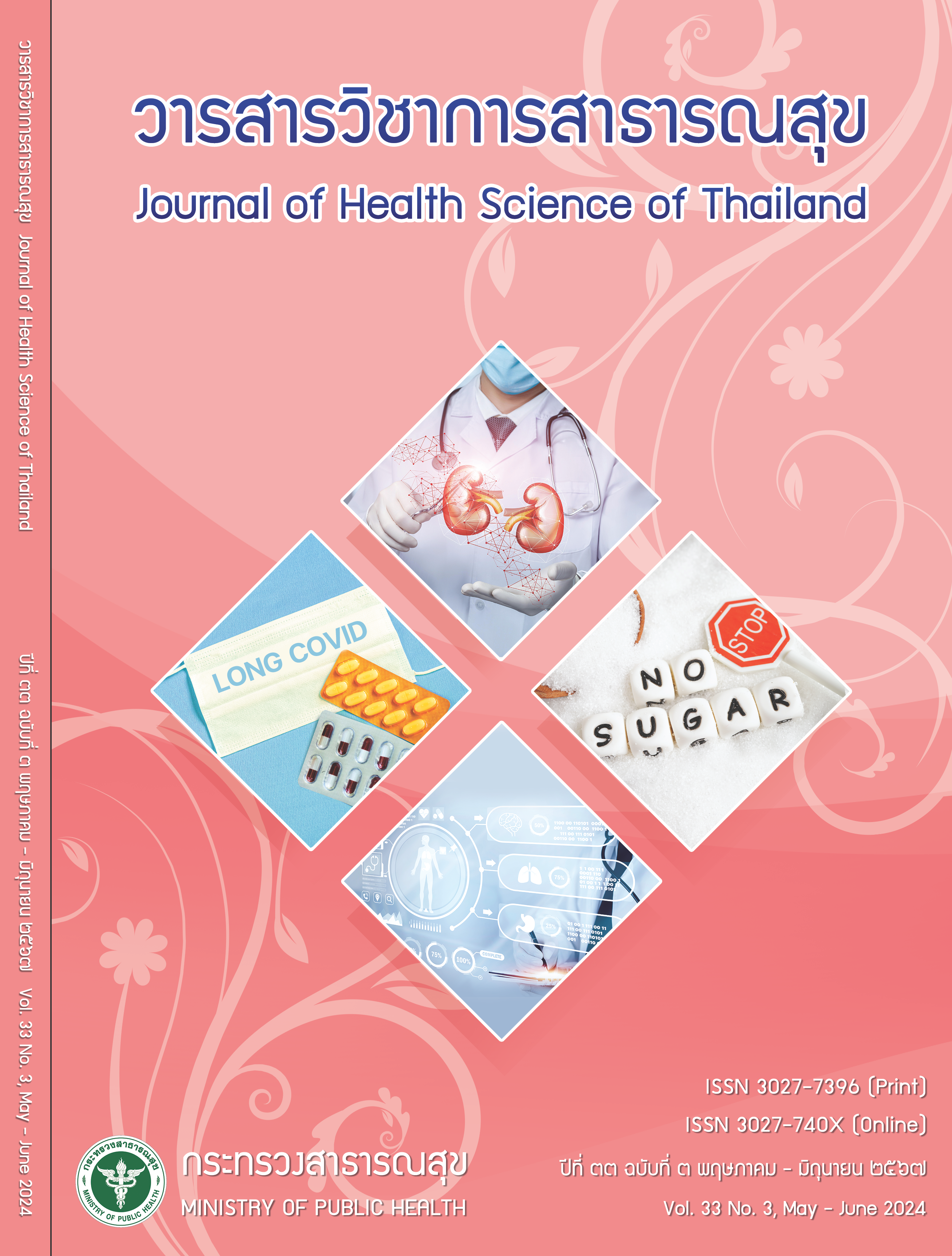Mechanisms Development for Driving COVID-19 Pandemics Prevention in Educational Institutions in Thailand
Keywords:
driving mechanisms, COVID-19 pandemics prevention, educational institutionsAbstract
This research aimed to study the mechanisms development for driving COVID-19 pandemics prevention in educational institutions in Thailand and evaluate the preparation measures before the start of the semester 1 in the academic year 2022. The samples were purposively selected, including 10 senior executives of the Ministry of Public Health and Ministry of Education. Qualitative data were collected through in-depth interviews based on structured questions. Data were analyzed using content analysis. Quantitative sample group were 36,751 educational institutions that performed self-assessment on their preparation for COVID-19 prevention for semester 1 of academic year 2022 through the Thai Stop COVID Plus system. The data were analyzed by frequencies, percentages and tested of spatial relationships including the use of Local Indicators of Spatial Association (LISA) study. It was found that the development of mechanisms to drive measures to COVID-19 pandemics prevention in educational institutions consisted of (1) driving operations with participation by the committee driving public health measures in preparation for the opening of the semester on COVID-19 prevention under the integrated policy cooperation at the central level and regional operations at the area level; (2) setting the direction of measures guidelines for practice and policy proposals; (3) transferring policies and implementation measures to network partners and educational institutions; and (4) monitoring the performance of educational institutions through digital technology. Among the overall educational institutions, 78.40% of them participated in the self-evaluation which covered 6 dimensions; 99.36% of them passed all 20 items; and 0.45% passed the first-dimension measure, items 1-12. The analysis results found that the higher percentage of provinces with educational institutions that had passed the preparation assessment after the school opening compared to the period before the start of school season indicated the effectiveness of the measures and the high level of compliance of the educational institutions. As a result, there was no COVID-19 case detected in educational institutions; which led to the confidence on the preparedness and safety for school opening. It was recommended that the systems and mechanisms should be developed to drive measures to COVID-19 prevention of other communicable diseases in educational institutions. and creating cooperation network with partners to drive forward health promotion work for vulnerable children.
Downloads
References
กรมควบคุมโรค กระทรวงสาธารณสุข. แนวทางการป้องกัน และควบคุมโรคติดเชื้อไวรัสโคโรนา 2019 ในสถานศึกษา [อินเทอร์เน็ต]. 2563 [สืบค้นเมื่อ 19 ธ.ค. 2565]. แหล่ง ข้อมูล: https://ddc.moph.go.th/viralpneumonia/file/ introduction/introduction170563.pdf
กรมอนามัย กระทรวงสาธารณสุข. คู่มือการปฏิบัติสำหรับ สถานศึกษาในการป้ องกันการแพร่ระบาดของโรคโควิด-19. ครั้งที่ 1. นนทบุรี: คิวแอดเสอร์ไทซิ่ง; 2563.
ศูนย์บริหารสถานการณ์โควิด-19 (ศบค.). สถานการณ์ COVID-19 ประจำวันที 1 พฤศจิกายน 2564 [อินเทอร์เน็ต].2564 [สืบค้นเมื่อ 19 ธ.ค. 2565]. แหล่งข้อมูล: https:// media.thaigov.go.th/uploads/public_img/ source/011164.pdf
สำนักส่งเสริมสุขภาพ กรมอนามัย. แบบประเมินตนเอง เตรียมความพร้อมก่อนเปิดภาคเรียนเพื่อเฝ้าระวังและ ป้องกันการแพร่ระบาดของโรคโควิด-19 ภาคการศึกษาที่ 1 ปีการศึกษา 2565 [อินเทอร์เน็ต]. 2565 [สืบค้นเมื่อ 19 ธ.ค. 2565]. แหล่งข้อมูล: https://stopcovid.anamai.moph. go.th/
Tobler WR. A computer movie simulating urban growth in the Detroit Region. Economic Geography 1970;46: 234–40.
Anselin L, Syabri I, Kho Y. GeoDa: an introduction to spatial data analysis. Geographical Analysis 2006;38:5- 22.
จิรกิติ์ ทองปรีชา. การบริหารจัดการการเรียนการสอน ภายใต้สถานการณ์ COVID-19 ระดับมัธยมศึกษาพื้นที่ โรงเรียนวชิรธรรมสาธิต เขตพระโขนง กรุงเทพมหานคร [อินเทอร์เน็ต]. 2563 [สืบค้นเมื่อ 19 ธ.ค. 2565]. แหล่ง ข้อมูล: https:// http://www3.ru.ac.th/mpa-abstract/ files/2562_ 1597914679_6114832031.pdf
บัณฑิต เกียรติจตุรงค์. การพัฒนารูปแบบการมีส่วนร่วมของ ภาคีเครือข่ายในการป้องกันและควบคุมโรคติดเชื้อไวรัส โคโรนา 2019 (COVID-19) อำเภอเมืองยาง จังหวัด นครราชสีมา [อินเทอร์เน็ต]. 2564 [สืบค้นเมื่อ 19 ธ.ค. 2565]. แหล่งข้อมูล: https://he02.tci-thaijo.org/index. php/jkkpho/article/view/255291
ปาลีรัตน์ วงศ์ฤทธิ์. คู่มือการจัดการเรียนการสอนและ มาตรการป้ องกันในสถานการณ์โรคติดเชื้อไวรัสโคโรนา 2019 (COVID-19) สำหรับแกนนำดูแลสุขภาพนักเรียน โรงเรียนนานาชาติเทศบาลนครนครศรีธรรมราช [อินเทอร์เน็ต]. 2565 [สืบค้นเมื่อ 19 ธ.ค. 2565]. แหล่ง ข้อมูล: https://kb.hsri.or.th/dspace/handle/11228/ 5708?locale-attribute=th
ชำนาญ ไวแสน. การรับรู้และความพร้อมการนำแผนและ มาตรการบริหารสถานการณ์โรคโควิด-19 สู่โรคประจำถิ่น ของผู้ปฏิบัติงานหน่วยปฏิบัติการควบคุมโรคติดต่อ พื้นที่ จังหวัดบึงกาฬ [อินเทอร์เน็ต]. 2565 [สืบค้นเมื่อ 19 ธ.ค. 2565]. แหล่งข้อมูล: https://bkpho.moph.go.th/ssjweb/ bkresearch/require/files/post-doc/20220717213724. pdf
สำนักงานเขตพื้นที่การศึกษาประถมศึกษาสุราษฎร์ธานี เขต 2 สำนักงานคณะกรรมการการศึกษาขั้นพื้นฐาน กระทรวงศึกษาธิการ. การติดตามและนิเทศการเตรียมความพร้อม เปิดภาคเรียนที่ 1 ปีการศึกษา 2565 ในการเปิด เรียน onsite ปลอดภัยอยู่ได้กับโควิด-19 ของสถานศึกษาสังกัด สำนักงานเขตพื้นที่การศึกษาประถมศึกษาสุราษฎร์ธานี เขต 2 [อินเทอร์เน็ต]. 2565 [สืบค้นเมื่อ 19 ธ.ค. 2565]. แหล่ง ข้อมูล: https://www.surat2.go.th/2021/files/com_ news_result/2022-11_cc5386c7f7a7829.pdf
กรมอนามัย กระทรวงสาธารณสุข. คู่มือมาตรการและ แนวทางในการดูแลด้านอนามัยสิ่งแวดล้อม สถานการณ์การ ระบาดของโรคติดเชื้อไวรัสโคโรนา 2019 (COVID-19) [อินเทอร์เน็ต]. 2563 [สืบค้นเมื่อ 19 ธ.ค. 2565]. แหล่ง ข้อมูล: https://COVID19.anamai.moph.go.th/web-upload/2xdccaaf3d7f6ae30ba6ae1459eaf3dd66/m_document/6730/34033/file_download/ecb4a988cd5b3244c0a1a20cfbb667cf.pdf
ราชวิทยาลัยกุมารแพทย์แห่งประเทศไทย. การเปิดเรียนอย่าง ปลอดภัยในสถานการณ์การระบาดของโรคโควิด-19 คำ แนะนำสำหรับโรงเรียน ผู้ปกครอง และชุมชน [อินเทอร์เน็ต]. 2564 [สืบค้นเมื่อ 19 ธ.ค. 2565]. แหล่งข้อมูล: https:// tmc.or.th/Media/media-2021-06-14-11-53-56.pdf
กรมอนามัย กระทรวงสาธารณสุข. คู่มือการเฝ้าระวังติดตาม และแผนเผชิญเหตุรองรับสถานการณ์การแพร่ระบาดของ โรคโควิด-19 ในสถานศึกษา. ครั้งที่ 1. กรุงเทพมหานคร: องค์การสงเคราะห์ทหารผ่านศึก; 2563.
กรมอนามัย กระทรวงสาธารณสุข. แนวปฏิบัติยกระดับความ ปลอดภัยมั่นใจไร้โควิด-19 ระลอกใหม่ ในสถานศึกษา. ครั้ง ที่ 1. กรุงเทพมหานคร: ชุมนุมสหกรณ์การเกษตรแห่ง ประเทศไทย; 2564.
กรกมล ศรีวัฒน์. เปิดโรงเรียนอีกครั้งดีไหม? เปิดงานวิจัย การแพร่ระบาดของโควิด-19 ในสถานศึกษา [อินเทอร์เน็ต]. 2564 [สืบค้นเมื่อ 19 ธ.ค. 2565]. แหล่งข้อมูล: https:// www.the101.world/school-and-COVID19-transmission/
รุ่งเรือง กิตผาติ วรรณฤดี อิสรานุวัฒน์ชัย ยศ ตีระวัฒนานนท์ กุมารี พัชนี ภิชารีย์ กรุณายาวงศ์ ธมลวรรณ ดุลสัมพันธ์ และ คณะ. Policy Brief ฉบับที่ 120: ถอดบทเรียนนโยบายอยู่ กับโควิด-19 จากประเทศทั่วโลก ประเทศไทยควรทำ อย่างไร. นนทบุรี: โครงการประเมินเทคโนโลยีและนโยบาย ด้านสุขภาพ HiTAP; 2565.
Downloads
Published
How to Cite
Issue
Section
License
Copyright (c) 2024 Ministry of Public Health

This work is licensed under a Creative Commons Attribution-NonCommercial-NoDerivatives 4.0 International License.







